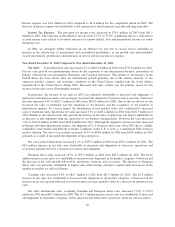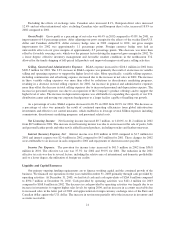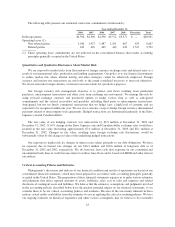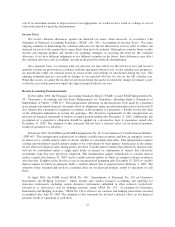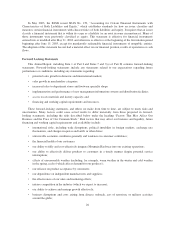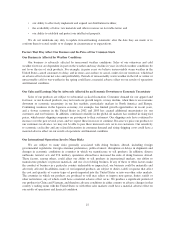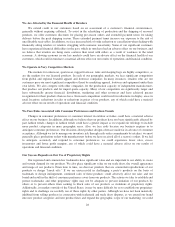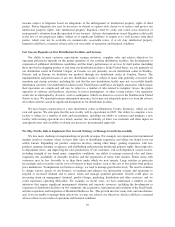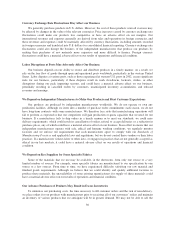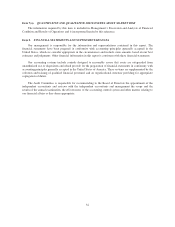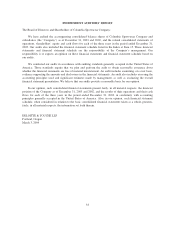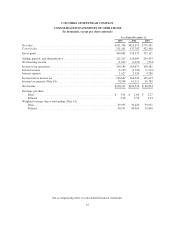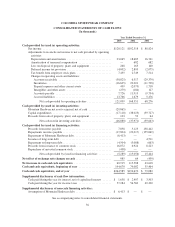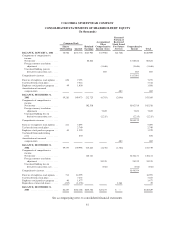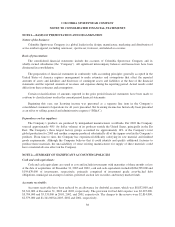Columbia Sportswear 2003 Annual Report Download - page 34
Download and view the complete annual report
Please find page 34 of the 2003 Columbia Sportswear annual report below. You can navigate through the pages in the report by either clicking on the pages listed below, or by using the keyword search tool below to find specific information within the annual report.become subject to litigation based on allegations of the infringement of intellectual property rights of third
parties. Future litigation also may be necessary to defend us against such claims or to enforce and protect our
intellectual property rights. Any intellectual property litigation could be costly and could cause diversion of
management’s attention from the operation of our business. Adverse determinations in any litigation could result
in the loss of our proprietary rights, subject us to significant liabilities or require us to seek licenses from third
parties, which may not be available on commercially reasonable terms, if at all. Any intellectual property
litigation could have a material adverse effect on our results of operations and financial condition.
Our Success Depends on Our Distribution Facilities and Systems
Our ability to meet customer expectations, manage inventory, complete sales and achieve objectives for
operating efficiencies depends on the proper operation of our existing distribution facilities, the development or
expansion of additional distribution capabilities and the timely performance of services by third parties (including
those involved in shipping product to and from our distribution facilities). In the United States, we rely primarily on
our distribution center in Portland, Oregon; in Canada, we rely primarily on our distribution center in Strathoy,
Ontario; and in Europe we distribute our products through our distribution center in Cambrai, France. The
implementation and performance of any new distribution facility is subject to many risks generally associated with
transition and startup activities, including the risk that the new distribution facility may not successfully handle
distribution activities. Our distribution facilities in the United States and France are highly automated, which means
their operations are complicated and may be subject to a number of risks related to computer viruses, the proper
operation of software and hardware, electronic or power interruptions, or other system failures. Our operations
could also be interrupted by disasters, such as earthquakes (which are known to occur in the Northwestern United
States) or fires. We maintain business interruption insurance, but it may not adequately protect us from the adverse
effect that could be caused by significant disruptions in our distribution facilities.
We have begun construction of a new distribution center in Henderson County, Kentucky, which we will
own and operate. We anticipate that the new facility will be operational in 2005. Our ability to complete a new
facility is subject to a number of risks and uncertainties, including our ability to construct and integrate a new
facility with existing operations in a timely manner, the availability of labor, raw materials and other inputs on
anticipated terms and our ability to obtain any necessary governmental approvals.
We May Not Be Able to Implement Our Growth Strategy or Manage Growth Successfully
We face many challenges in implementing our growth strategies. For example, our expansion into international
markets involves countries where we have little sales or distribution experience and where our brand is not yet
widely known. Expanding our product categories involves, among other things, gaining experience with new
products, gaining consumer acceptance, and establishing and protecting intellectual property rights. Increasing sales
to department stores, and improving the sales productivity of our customers, will each depend on various factors,
including strength of our brand name, competitive conditions, our ability to manage increased sales and future
expansion, the availability of desirable locations and the negotiation of terms with retailers. Future terms with
customers may be less favorable to us than those under which we now operate. Large retailers in particular
increasingly seek to transfer various costs of business to their vendors, such as the cost of lost profits from product
price markdowns. To implement our business strategy, we need to manage growth effectively. We need to continue
to change various aspects of our business, to maintain and enhance our information systems and operations to
respond to increased demand and to attract, retain and manage qualified personnel. Growth could place an
increasing strain on management, financial, product design, marketing, distribution and other resources, and we
could experience operating difficulties. For example, in recent years, we have undertaken a number of new
initiatives that require significant management attention and corporate resources, including the development or
expansion of distribution facilities on two continents, the acquisition, rejuvenation and extension of the Sorel brand,
and the acquisition and integration of Mountain Hardwear, Inc. This growth involves many risks and uncertainties
and, if we are unable to manage them effectively, we may not achieve our objectives, which could have a material
adverse effect on our results of operations and financial condition.
29



